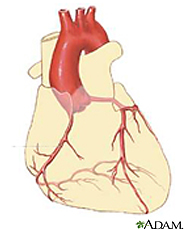 |
 |
 |
Other Health Topics:

-
Related Topics
-
Go Local
- Services and providers for Angioplasty in the U.S.
-
National Institutes of Health
- The primary NIH organization for research on Angioplasty is the National Heart, Lung, and Blood Institute
Languages
- Arabic (العربية)
- Bosnian (Bosanski)
- Chinese - Simplified (简体中文)
- Chinese - Traditional (繁體中文)
- French (français)
- Hindi (हिन्दी)
- Japanese (日本語)
- Korean (한국어)
- Russian (Русский)
- Somali (af Soomaali)
- Spanish (español)
- Ukrainian (Українська)
- Vietnamese (Tiếng Việt)
Angioplasty
Also called: Balloon angioplasty
If you have coronary artery disease, the arteries in your heart are narrowed or blocked by a sticky material called plaque. Angioplasty is a procedure to restore blood flow through the artery.
The doctor threads a thin tube through a blood vessel in the arm or groin up to the involved site in the artery. The tube has a tiny balloon on the end. When the tube is in place, the doctor inflates the balloon to push the plaque outward against the wall of the artery. This widens the artery and restores blood flow.
Doctors may use angioplasty to
- Reduce chest pain caused by reduced blood flow to the heart
- Minimize damage to heart muscle from a heart attack
Each year more than a million people in the United States have coronary angioplasty.
National Heart, Lung, and Blood Institute
Start Here
-
Angioplasty
 (National Heart, Lung, and Blood Institute)
(National Heart, Lung, and Blood Institute)
-
Coronary Angiogram and Angioplasty
 (Patient Education Institute) - Requires Flash Player
(Patient Education Institute) - Requires Flash Player
Also available in Spanish
-
Stents
 (National Heart, Lung, and Blood Institute)
(National Heart, Lung, and Blood Institute)
| Basics | Learn More | Multimedia & Cool Tools |
|---|---|---|
| Research | Reference Shelf | For You |
-
Overviews
-
Balloon Angioplasty and Stents(Texas Heart Institute)
Also available in Spanish
- Coronary Angioplasty and Stenting: Opening Clogged Heart Arteries(Mayo Foundation for Medical Education and Research)
-
Balloon Angioplasty and Stents(Texas Heart Institute)
-
Latest News
- 2 Techniques Found Effective in Carotid Artery Narrowing(09/06/2008, HealthDay)
- Angioplasty Scoring System Predicts Risk of Death(08/27/2008, HealthDay)
- Reaching the Heart through the Wrist(08/19/2008, HealthDay)
- More News on Angioplasty
-
Rehabilitation/Recovery
- Cardiac Rehabilitation: Building a Better Life After Heart Disease(Mayo Foundation for Medical Education and Research)
-
Related Issues
- Angioplasty and Stenting(Society for Vascular Surgery)
- Angioplasty, Laser(American Heart Association)
- Atherectomy(American Heart Association)
- Drug-Eluting Stents: Do They Increase Heart Attack Risk?(Mayo Foundation for Medical Education and Research)
- Glycoprotein IIb/IIIa Inhibitors(Cleveland Clinic Foundation)
-
Tutorials
-
Coronary Angiogram and Angioplasty(Patient Education Institute) - Requires Flash Player
Also available in Spanish
-
Coronary Angiogram and Angioplasty(Patient Education Institute) - Requires Flash Player
-
Videos
- Cardiac Catheterization with Angioplasty and Stent Placement(OR-Live) - Requires media player - One hour program - 6/14/2007
- Cardiac Catheterization with Angioplasty and Stent Placement(OR-Live) - Requires media player - One hour program - 5/16/2007
- Cryoplasty Therapy: Innovative Technique to Remedy Blood Vessel Blockage Resulting from Peripheral Arterial Disease(OR-Live) - Requires media player - One hour program - 5/02/2007
- Procedures for Improving Circulation to the Legs(OR-Live) - Requires media player - One hour program - 5/10/2007
-
Anatomy/Physiology
- How the Heart Works(National Heart, Lung, and Blood Institute)
-
Clinical Trials
-
ClinicalTrials.gov: Angioplasty
 (National Institutes of Health)
(National Institutes of Health)
-
ClinicalTrials.gov: Angioplasty
-
Research
- Angioplasty More Cost-Effective Than Bypass Surgery for Some Men(American Heart Association)
-
Clinical Trial Results Find Late Angioplasty After Heart Attack Offers No Advantage over Standard Drug Therapy
 (National Heart, Lung, and Blood Institute)
(National Heart, Lung, and Blood Institute)
- Risk and Outcome Similar for Bypass Surgery, Drug-Eluting Stents(American Heart Association)
-
Journal Articles
References and abstracts from MEDLINE/PubMed (National Library of Medicine)
- Article: Mechanical reperfusion: treat well, treat on time too.
- Article: Bivalirudin versus unfractionated heparin during percutaneous coronary intervention.
- Article: Effect of PCI on quality of life in patients with...
- Angioplasty -- see more articles
-
Dictionaries/Glossaries
- Heart Surgery Terms(Society of Thoracic Surgeons)
- Organizations Return to top
-
Statistics
- Angioplasty and Cardiac Revascularization Statistics(American Heart Association)
-
Women
- Angioplasty and Stents(Cardiovascular Research Foundation)
| Home | Health Topics | Drugs & Supplements | Encyclopedia | Dictionary | News | Directories | Other Resources | |
| Disclaimers | Copyright | Privacy | Accessibility | Quality Guidelines U.S. National Library of Medicine, 8600 Rockville Pike, Bethesda, MD 20894 National Institutes of Health | Department of Health & Human Services |
Date last updated: 08 September 2008 Topic last reviewed: 16 May 2008 |






